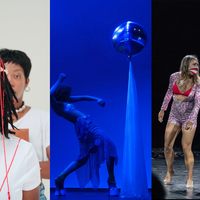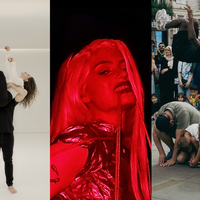Fri 17 Jan: Eira Dance Theatre, Magdalena Mannion and Bea Bidault

News Story
Opening the evening with a modern reframing of flamenco dance, Magdalena Mannion delivers a hypnotic portrayal of Brontë’s Miss Havisham. Throughout Jane,Mannion commands the room with every zapateado (foot stomp) and vuelta (turn), carving out the space as if thick with bodies despite the spinster’s isolation. She is accompanied on stage by cellist Colin Alexander and an unnamed percussionist who plays the triangle with scene-stealing dedication. Whilst the work is well-executed, Mannion’s clean lines lack the frenzy promised by an ode to one of literature’s greatest outcasts. Perhaps Mannion could afford to take more risks, especially on a stage well accustomed to the raw and daring, but the polished nature of the piece makes it highly watchable.
In Katy Perry’s 2010 anthem Firework, she asks “Do you ever feel, like a plastic bag, drifting through the wind, wanting to start again?”. Whilst this might not have inspired Bea Bidault’s contemplative solo, she seems to answer yes. Surrounded by a constellation of inflated disposable ponchos, the artist showcases poignant imagery as she journeys through elation and crushing vulnerability. Reminiscent of Warhol’s Silver Clouds, used by Merce Cunningham in his 1968 performance RainForest, Bidault’s sculptures are instead transparent, allowing the audience to experience the full distortion of her face as she hugs, and then sobs into, a plastic torso. Bidault’s talents are abundant. Throughout the work, she speaks, sings and jolts, her body animated and then suddenly discarded. Arguably, the solo works best at its simplest: filling and emptying one of her cloud-like companions with smoke in a tender embrace that nearly suffocates the front row.
Golden Leaves completes an evening of performances contemplating solitude, with a nod to Japanese Butoh via Gloucestershire’s Forest of Dean. Beginning with a Pinterest board-like compilation of scenic woodland projections, the piece sprouts into a meditative sequence of slowly moving images: Billy Maxwell Taylor makes a steaming cuppa while Maggie Tin Lok Chan creeps backwards towards the audience as if treading an invisible tightrope. The work does bring a blood-pressure-lowering calm to the auditorium, but it neglects the radical nature of the Japanese “dance of darkness” and feels somewhat safe in its commitment to Zen.
- Gian Sanghera-Warren
Jane is a successful solo vehicle for Magdalena Mannion, but a less fruitful collaboration between her and cellist Colin Alexander, which is a problem as that's how it's sold. Mannion has a powerful, understated presence as a dancer, which works well for her hybrid movement language; flamenco lower half and inoffensive, contemporary dance upper half. Alexander, and a fellow musician on the triangle(s) move around the space in between playing with no real purpose, and all the while Mannion is in her own world, often looking up into the pool of light she's bathed in. It's all fine, but equally uneventful and disconnected.
Les Nuages is a super accomplished piece, but also raises questions about the spirit of Resolution. The work sees choreographer Bea Bidault, supported by a creative team of no less than eight collaborators…which seems OTT for a choreography festival IMHO. Regardless, what Bidault (et al) has created is an original work, with at times, too much to say. Sections include balloon sculpture, clouds of smoke, recorded narration, live monologues, extended dance sequences and a full on song! Bidault moves with an irresistible combination of energy and precision, and the intimate work with her inflatable, transparent friends allows for an insight into emotional proximity one often doesn't witness when part of the embrace in question. Clever stuff, but content overloading needs a rethink.
Golden Leaves communicates an obvious interest in zen philosophy, but fundamentally leaves the observer disinterested. The overall feel is tasteful, starting with atmospheric, nature images projected onto the back wall, a tea ceremony follows which highlights the beauty of everyday behaviour and slow motion movement is accompanied by the quiet charm of a wind chime in action. The piece aimed to convey “stillness in the busyness”, and I'd argue it went a step further. My final thought being; it's interesting how nothing is nothing, yet something can be boring.
- Matthew Paluch


